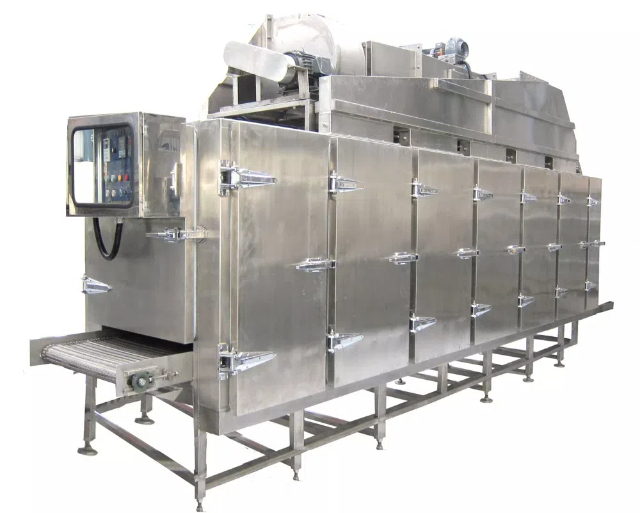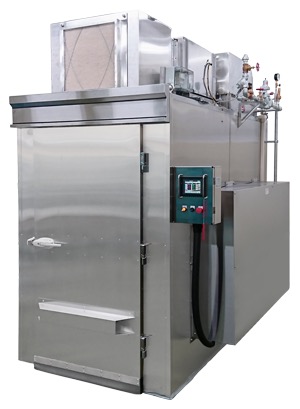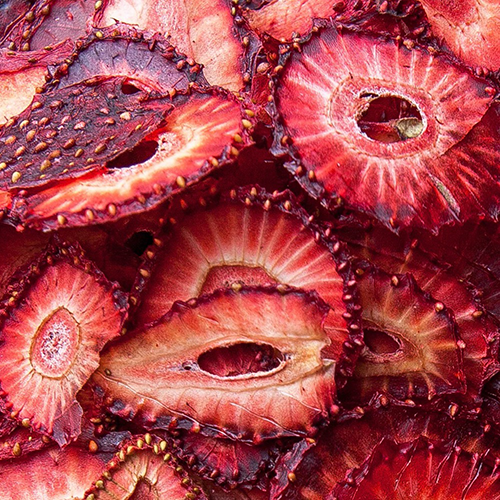
Content Menu
● What are Hang Type Drying Machines?
● Core Components and Design
● The Drying Process
● Forced Convection
● Dehumidification Systems
● Energy Efficiency
● Heat Pump Dryers
● Benefits of Hang Type Drying Machines
● Applications in the Food Industry
● Commercial and Industrial Models
● Intelligent Digital Control
● Maintenance and Sanitation
● Conclusion
● FAQ
>> 1. What types of food can be dried using hang-type drying machines?
>> 2. How does a hang-type drying machine ensure even drying?
>> 3. What are the benefits of using heat pump technology in hang-type drying machines?
>> 4. Are hang-type drying machines suitable for small-scale food production?
>> 5. How do intelligent digital controls enhance the operation of hang-type drying machines?
● Citations:
Hang-type drying machines represent a significant advancement in food processing technology, offering a gentle yet effective method for moisture removal. This article delves into the science, applications, and benefits of these machines, highlighting their importance in modern food production.

What are Hang Type Drying Machines?
Hang type drying machines utilize a vertical hanging system to dry food items. These machines suspend products such as fruits, vegetables, meats, and herbs in a controlled environment where air circulation and temperature can be finely tuned. This method minimizes bruising and damage to delicate products, and also allows for a larger quantity of food to be processed in a smaller footprint than some other drying methods.
Core Components and Design
The core components of a hang-type drying machine are designed to ensure optimal performance and food safety. The choice of materials and the precision of engineering directly impact the quality of the dried product.
1. Hangers: Typically constructed from food-grade stainless steel 304 for corrosion resistance, durability, and hygienic properties. The design of the hangers themselves can vary based on the type of food being dried. For example, hangers for delicate herbs might feature a mesh design to prevent leaves from falling through, while those for heavier items like sausages would be sturdier and spaced further apart.
2. Stainless Steel Hangers (Example image link, replace with actual image)
3. Machine Housing: Also uses stainless steel to prevent corrosion from acids in food. The housing is insulated to maintain a consistent temperature inside the drying chamber, reducing energy loss and improving efficiency. Doors are sealed to prevent moisture leakage and maintain a controlled drying environment.
4. Enclosed Chamber: Provides a controlled environment. The dimensions of the chamber are carefully calculated to optimize airflow and maximize the number of hangers that can be accommodated.
5. Air Circulation System: Ensures even drying. The placement and type of fans are crucial. Axial fans are often used for their high airflow capacity, while centrifugal fans provide higher static pressure, ensuring that air reaches all areas of the drying chamber. Airflow patterns are designed to avoid dead zones where moisture can accumulate.
6. Heating Elements: Provide controlled heat. Electric resistance heaters are commonly used for their precise temperature control. The heating elements are strategically positioned to ensure uniform heat distribution throughout the chamber. In some advanced models, infrared heaters are used to provide more efficient and targeted heating.
7. Control Panel: Allows users to manage temperature and humidity. Modern control panels feature user-friendly interfaces with touchscreens and programmable logic controllers (PLCs). These controls allow users to set precise temperature and humidity profiles for different food products, ensuring optimal drying results. The control panel also monitors and displays real-time data on temperature, humidity, and drying time, allowing operators to track the progress of the drying process and make adjustments as needed.
The Drying Process
The fundamental principle behind hang-type drying machines is to remove moisture from food products to inhibit microbial growth and prevent spoilage. This is achieved through a carefully controlled process of evaporation, where heat raises the temperature of the food, causing water molecules to transition from a liquid to a gaseous state. The evaporated moisture is then carried away by a circulating air stream. The suspended arrangement maximizes surface area exposure, facilitating faster and more uniform drying. The key is maintaining the correct balance of temperature, humidity, and airflow for the specific food being dried.

Forced Convection
Forced convection is the key mechanism by which hang-type drying machines achieve efficient and uniform drying. Fans create a continuous flow of air across the surface of the suspended food products, rapidly carrying away evaporated moisture. This forced airflow significantly accelerates the drying process compared to natural convection. The strategic placement of fans and air ducts ensures that the entire drying chamber is evenly ventilated, eliminating "dead zones" where moisture can accumulate and hinder drying. Many machines also allow the operator to change the wind direction regularly to provide uniform drying on the surface of the food. This is particularly important for products like noodles and sausages, where consistent texture and moisture content are critical. Some advanced systems utilize sensors to detect moisture levels in different areas of the drying chamber and automatically adjust airflow to compensate for variations.
Dehumidification Systems
In addition to forced convection, many hang-type drying machines incorporate dehumidification systems to further enhance the drying process. Dehumidifiers remove moisture from the air circulating within the drying chamber, creating a drier environment that promotes faster and more efficient evaporation. There are two main types of dehumidification systems:
1. Condensation Dehumidifiers: Cool the air below its dew point, causing moisture to condense on a cold surface. The condensed water is then drained away. Condensation dehumidifiers are relatively inexpensive and effective at removing large amounts of moisture from the air.
2. Desiccant Dehumidifiers: Use a desiccant material, such as silica gel or zeolite, to absorb moisture from the air. The desiccant material is then regenerated by heating it to remove the absorbed moisture. Desiccant dehumidifiers are more energy-efficient than condensation dehumidifiers and can operate at lower temperatures, making them suitable for drying heat-sensitive food products.
Energy Efficiency
Energy efficiency is a critical consideration in modern food drying technology, driven by both environmental concerns and the need to reduce operating costs. Hang-type drying machines equipped with heat pump technology offer significant energy savings compared to traditional drying methods. Heat pumps work by extracting heat from the exhaust air and transferring it back to the incoming air stream, reducing the amount of energy required to heat the drying chamber. This can result in energy savings of up to 75%, making heat pump dryers a more sustainable and cost-effective option for many food processing applications. In addition to heat pumps, other energy-saving features include insulated chambers, variable-speed fans, and intelligent control systems that optimize drying parameters based on real-time conditions.
Heat Pump Dryers
Heat pump dryers utilize a refrigeration cycle to extract heat from the exhaust air and transfer it back to the incoming air stream. There are three main types of heat pump dryers:
1. Open-Loop Heat Pump Dryers: Draw fresh air from the environment, heat it using the heat pump, and then exhaust the humid air back into the environment. Suitable for applications where a constant supply of fresh air is required, such as drying certain types of herbs that benefit from ventilation.
2. Closed-Loop Heat Pump Dryers: Recirculate the air within the drying chamber, continuously removing moisture and reheating the air using the heat pump. Offer higher energy efficiency compared to open-loop systems but may require additional dehumidification to prevent excessive humidity buildup. This type is ideal for drying products where maintaining a consistent atmosphere is important.
3. Open/Closed-Loop Heat Pump Dryers: Combine the features of both open-loop and closed-loop systems, allowing for flexible operation depending on the specific drying requirements. They can switch between recirculating air for maximum energy efficiency and drawing in fresh air for better moisture removal, providing the most versatile and adaptable drying solution.
Benefits of Hang Type Drying Machines
1. Gentle Drying Process: The hanging method minimizes bruising and damage to delicate products. This is particularly important for fruits and vegetables with a high water content, such as berries and leafy greens.
2. Controlled Environment: Users can adjust temperature and humidity levels to suit specific food types. This precise control allows for optimal drying conditions that preserve the quality, flavor, and nutritional value of the food.
3. Energy Efficiency: These machines often incorporate advanced technologies that reduce energy consumption while maintaining optimal drying conditions. This can result in significant cost savings over time.
4. Preservation of Nutritional Value: By controlling the drying process, these machines help retain vitamins and minerals that might be lost in traditional drying methods. Low-temperature drying is particularly effective at preserving heat-sensitive nutrients.
5. Versatility: Suitable for a wide range of products including fruits, vegetables, meats, and herbs. This versatility makes hang-type drying machines a valuable investment for food processing companies that handle a variety of products.
6. Space Saving Design: The vertical arrangement allows for efficient use of space in production facilities. This is especially beneficial for companies with limited floor space.
7. Automated Systems: Many models come with automation features that enhance operational efficiency and consistency. Automatic loading and unloading systems, as well as automated cleaning cycles, can further reduce labor costs and improve productivity.
8. Reduced Risk of Contamination: The enclosed design minimizes exposure to contaminants from the environment. HEPA filters can be integrated into the air circulation system to remove dust and other airborne particles, ensuring a clean and hygienic drying environment.
9. Even Drying: The suspended arrangement ensures that all surfaces of the food products are exposed to consistent airflow, preventing uneven drying. This results in a more uniform product with consistent texture and moisture content.
Applications in the Food Industry
Hang type drying machines are utilized across various sectors within the food industry, playing a crucial role in preserving food and extending its shelf life.
1. Fruit and Vegetable Drying: Ideal for producing dried fruits and vegetables that retain their flavor and color. Commonly dried items include apples, bananas, tomatoes, and peppers. The controlled drying process prevents excessive shrinkage and maintains the structural integrity of the produce.
2. Herb Drying: Preserves essential oils and flavors in culinary herbs such as basil, thyme, and oregano. This is particularly important for maintaining the potency of herbs used in cooking. Low-temperature drying helps prevent the loss of volatile compounds, ensuring that the herbs retain their aroma and flavor.
3. Meat Drying: Commonly used in jerky production where moisture removal is crucial for safety and shelf life. The controlled environment helps prevent spoilage while enhancing flavor. Precise temperature control is essential for inhibiting the growth of harmful bacteria.
4. Seafood Drying: Fish and other seafood can also be dried using hang type machines, providing a method to create shelf-stable products like dried fish or shrimp. Proper drying techniques are essential for preventing the formation of undesirable odors and flavors.
5. Noodle and Pasta Drying: Ideally suited for drying noodles and pasta, where maintaining shape and preventing sticking are crucial. The suspended arrangement allows for uniform drying and prevents the noodles from clumping together. Controlled drying conditions help preserve the texture and color of the noodles, resulting in a high-quality finished product. Different types of noodles and pasta require different drying parameters to achieve optimal results.
6. Sausage and Meat Drying: Offer a controlled environment for curing and drying sausages and other meat products. The precise control over temperature and humidity prevents the growth of harmful bacteria and promotes the development of desirable flavors. Smoking can also be integrated into the drying process to add flavor and enhance preservation.
Commercial and Industrial Models
Hang-type drying machines are available in a wide range of sizes and capacities to suit different production volumes. Commercial models are typically smaller and designed for use in restaurants, small food processing plants, and laboratories. Industrial models are larger and more robust, designed for high-volume production in large-scale food processing facilities. Capacity options range from small capacities of around 100kg to large capacities up to 10 tons. The choice of model depends on factors such as production volume, type of food being dried, and available floor space.
For automated food processing lines, continuous drying equipment offers a seamless and efficient solution. These systems typically consist of a conveyor belt or a series of hangers that move continuously through the drying chamber. The food products are loaded onto the conveyor belt at one end of the chamber and are automatically dried as they move through the controlled environment. Continuous drying systems offer high throughput and consistent drying results, making them ideal for large-scale production.
Intelligent Digital Control
Modern hang-type drying machines are equipped with intelligent digital controls that make operation easy and efficient. These controls allow for precise adjustment of temperature, humidity, and airflow and can be programmed with specific drying cycles for different food products. Programmable logic controllers (PLCs) can be used to automate the drying process, ensuring consistent results and reducing the need for manual intervention. Remote monitoring and control capabilities allow operators to monitor the drying process from a central location. Some advanced systems also incorporate artificial intelligence (AI) algorithms that learn from historical data and optimize drying parameters to achieve the best possible results.
Maintenance and Sanitation
Regular maintenance and sanitation are essential for ensuring the safe and efficient operation of hang-type drying machines. Key maintenance tasks include:
1. Cleaning the drying chamber and hangers regularly to prevent the buildup of food debris and microbial growth.
2. Inspecting and cleaning the air filters to maintain optimal airflow.
3. Checking the heating elements and fans for proper operation.
4. Lubricating moving parts to prevent wear and tear.
5. Calibrating the temperature and humidity sensors to ensure accurate readings.
Sanitation procedures should be followed to prevent contamination of the food products. This includes using food-grade cleaning agents and disinfectants and following proper cleaning protocols. Regular inspections and audits can help identify potential sanitation issues and ensure that the drying machine is operating in a hygienic manner.
Conclusion
Hang type drying machines represent a pivotal technology in the food processing industry, offering a blend of efficiency, precision, and product quality enhancement. From preserving the nutritional integrity of fruits and vegetables to ensuring the safety and flavor of meats and seafood, these machines cater to a diverse range of applications. As the demand for high-quality, shelf-stable food products continues to grow, hang-type drying machines will undoubtedly play an increasingly vital role in shaping the future of food production. Their ability to provide consistent, energy-efficient drying, coupled with advancements in automation and control, positions them as an indispensable asset for food manufacturers seeking to meet the evolving needs of consumers.

FAQ
1. What types of food can be dried using hang-type drying machines?
Hang-type drying machines are versatile and can be used for a wide range of food products, including fruits, vegetables, herbs, meats, seafood, noodles, and pasta. The specific drying parameters, such as temperature and humidity, can be adjusted to suit the needs of different food types.
2. How does a hang-type drying machine ensure even drying?
The suspended arrangement ensures that all surfaces of the food products are exposed to consistent airflow, preventing uneven drying and the formation of hard or soft spots. Many machines also allow the operator to change the wind direction regularly to provide uniform drying on the surface of the food. In addition, some advanced systems utilize sensors to detect moisture levels in different areas of the drying chamber and automatically adjust airflow to compensate for variations.
3. What are the benefits of using heat pump technology in hang-type drying machines?
Heat pump technology offers significant energy savings by extracting heat from the exhaust air and transferring it back to the incoming air stream, reducing the amount of energy required to heat the drying chamber. This can result in energy savings of up to 75%, making heat pump dryers a more sustainable and cost-effective option for many food processing applications.
4. Are hang-type drying machines suitable for small-scale food production?
Yes, hang-type drying machines are available in various sizes and capacities, including commercial models designed for use in restaurants, small food processing plants, and laboratories. These smaller models offer the same benefits as their larger counterparts, such as precise temperature and humidity control, energy efficiency, and even drying.
5. How do intelligent digital controls enhance the operation of hang-type drying machines?
Intelligent digital controls allow for precise adjustment of temperature, humidity, and airflow, and can be programmed with specific drying cycles for different food products, making operation easy and efficient. Programmable logic controllers (PLCs) can be used to automate the drying process, ensuring consistent results and reducing the need for manual intervention.
Citations:
[1] https://www.dryeratech.com/hang-type-drying-machines-gentle-on-fabrics-tough-on-moisture.html
[2] https://patents.google.com/patent/CN110207480A/zh
[3] https://www.dryeratech.com/the-science-behind-hang-type-drying-machines.html
[4] https://patents.google.com/patent/CN112481977B/zh
[5] https://www.bchydro.com/powersmart/residential/tips-technologies/hang-dry-laundry.html
[6] https://patents.google.com/patent/CN109252340A/zh
[7] https://www.zanussi.com.hk/appliances/dryers/
[8] https://patents.google.com/patent/CN1405396A/zh











